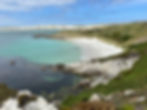- Hazel Prior
- Feb 17, 2023
Jan 25th - 26th
It is almost a culture shock to find ourselves in a town again, although Stanley is hardly a metropolis! Our wander around took us to the cathedral, Government House, several war memorials and the museum. The museum is a treasure trove of fascinating insights, especially the parts about Antarctic explorers and the moving accounts of experiences during the 1982 war. But the gift shops are mostly penguin-centric and even the local newspaper is named after our favourite bird!

We leapt at our last chance to see actual penguins: a trip to Gypsy Cove and Yorke Bay. However, today was the fated day of the 3 cruise ships so everywhere was suddenly milling with people. People! We are simply not used to them any more! We jostled along with them, gazing down on this idyllic beach that was all fenced off and guarded by penguin wardens because of the breeding colonies.

Yorke Bay is the second, much longer beach, and for years it was closed off too, due to mines laid during the Argentine occupation. Luckily the penguins were light enough to walk over them safely and remained unharmed. The mines have been cleared recently, so at last the Falklanders can enjoy this local beauty spot again. And beautiful it is, with miles of pale, smooth sands, rocky headlands, windswept dunes and views to the other islands across the glittering water.
Kings, gentoos and Magellanics were roaming about the shoreline, much to the thrill of our fellow human visitors. However, the cruise ship tourists had to head back by early afternoon so Ursula and I were left alone with the sea, sand and bird population, in our element again.

As always the gentoos entertained us with their food chases and the kings dazzled us with their sleek, shiny silver and yellow plumage. The ones that were moulting seemed self-conscious about their relative tattiness... but that's probably just me anthropomorphising. It's hard not to with penguins. Of course they have their own special penguin agendas that we know nothing about, but their interactions (whether it's flirting, competing, squabbling or nurturing their young) are reminiscent of our own. And their feet, beaks, eyes and flippers are so very expressive; utter riches for a writer's imagination.

Penguins are fabulous models for a photographer, too, since, unlike most wildlife, they're not camera-shy. Bursting with natural bravado and curiosity, they'll come right up to you and pose willingly. I'm thrilled with the photos and vids I've managed on my iphone (only a small percentage posted here) but you should see Ursula's array, some of which will contribute to her 'Mission Penguin' book, out next year. It will be a must for all penguin fans.
As we scrambled over the dunes I looked back at the dramatic contours of the Falklands with a pang at leaving it all behind. Still, I have finally seen penguins in the wild! Whatever the future holds, I'm carrying inside me a great glow of gratitude for the extraordinary time we've had here.

A postscript as I type this final blog up from my study back in the UK on a dark February evening...
'Remember the Penguins' was a little catchphrase I used in my novel, Call Of The Penguins. It's an exhortation to follow the penguins' example, to adopt their qualities of resilience and good cheer and to keep 'waddling on' no matter what life throws at you. After such an amazing trip, I think I can safely say for Ursula and myself that the two of us will always, ALWAYS 'remember the penguins!'














